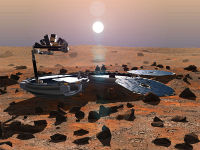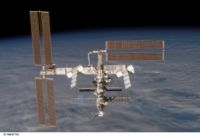Difference between revisions of "Solar panel"
m (solar concentrator link) |
(Net Energy Gain) |
||
| Line 10: | Line 10: | ||
A major drawback to using solar power is the requirement for some form of [[energy storage]] to keep power available during the Martian night. | A major drawback to using solar power is the requirement for some form of [[energy storage]] to keep power available during the Martian night. | ||
| + | |||
| + | ==Net energy gain (NEG)== | ||
| + | |||
| + | The production of photovoltaic cells consumes an amount of energy. This amount must be taken into account to find out, whether or not photovoltaic cells can be a long term source of energy. With current technology the breakeven energy payback time is about 2 to 4 years. Thin film cells have a better NEG than crystalline cells. Additionally, the [[wear lifespan]] of the cells must be considered. Due to the higher [[radiation]] damage on Mars compared with a terrestrial environment the wear lifespan is shorter. | ||
| + | |||
| + | ==Open issues== | ||
| + | |||
| + | *What is the exact NEG for a Martian environment? | ||
[[category:technology]] | [[category:technology]] | ||
[[category:energy]] | [[category:energy]] | ||
Revision as of 13:44, 2 January 2009

Solar Panels generate electric energy out of sunlight. Usually they are constructed from a semi-conductor such as silicon. Solar panels are frequently used in space primarily for satellites and space stations in Earth orbit and is the prime source of energy for Mars satellites, landers and rovers. Solar panels begin to lose usefulness for deep space and outer solar system missions (i.e. the Cassini mission to Saturn or the Voyager program) where radioisotope thermoelectric generators are the favoured (if controversial) means to generate electricity.

On Mars the sunlight is bright enough to use solar panels. The famous rovers Spirit and Opportunity have them. The experiences are terrific: Since July 2003 they are working fine, and the Martian winds have kept the surfaces clear of dust. However, the rovers cannot operate at full capacity during the Martian winter when the intensity of the sunlight is reduced, and dust storms have from time to time caused severe reductions in the available power, requiring the rovers to go into a low-power "hibernation" mode.
Solar concentrators increase the efficiency of solar panels by focusing the sunlight.
A major drawback to using solar power is the requirement for some form of energy storage to keep power available during the Martian night.
Net energy gain (NEG)
The production of photovoltaic cells consumes an amount of energy. This amount must be taken into account to find out, whether or not photovoltaic cells can be a long term source of energy. With current technology the breakeven energy payback time is about 2 to 4 years. Thin film cells have a better NEG than crystalline cells. Additionally, the wear lifespan of the cells must be considered. Due to the higher radiation damage on Mars compared with a terrestrial environment the wear lifespan is shorter.
Open issues
- What is the exact NEG for a Martian environment?






